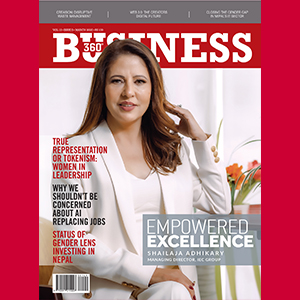
In Nepal, where gender roles and societal expectations have historically limited women’s participation in the workforce and decision-making positions, the rise of female leaders has been a significant indicator of progress. However, as the number of women in leadership grows, a fundamental question arises: are these women truly representative of an evolved and inclusive society or are they tokens used to meet diversity quotas without addressing the systemic barriers that hinder genuine quality?
This debate is particularly relevant in Nepal, a country where cultural norms, limited access to education, and patriarchal structures still present challenges to women’s participation in leadership. While the corporate sector has made notable strides in promoting gender equality, questions persist about the depth of this progress. Are women in leadership roles truly being empowered, or are they being placed in these positions as symbolic gestures to project an image of progress without meaningful and transformative changes? We will examine the fine line between tokenism and true representation, evaluating whether the growing visibility of women leaders is the result of genuine efforts to create an equitable and inclusive leadership landscape, or if it is simply a superficial response to global calls for diversity and inclusion.

In this opinion segment, Bharti Pande, Chief Brand & Strategy Officer, Laxmi Sunrise Bank; Bishakha Lakshmi Khadka, Head of Corporate Communications and CSR, Ncell; Karvika Thapa, CEO, Kimbu Tech; Manita Oli, Head of Institute, Shubhashree College of Management; and Sneh Rajbhandari, Director of Public Affairs, Communications and Sustainability, Coca-Cola Nepal, provide their perspectives on whether the progress women have made in leadership roles in Nepal is a true recognition of their acumen.
Do you believe the rise in women holding leadership positions is a reflection of merit-based inclusion or is it more of a symbolic gesture to fulfil diversity quotas?
Manita Oli: The rise of women in leadership roles is a positive step toward gender equality, but the question remains – are these positions truly based on merit, or are they simply a way to fulfil diversity quotas? In many cases, women achieve leadership roles through their skills, dedication and hard work. However, there are instances where organisations appoint women to leadership positions merely as a symbolic gesture, without giving them authority or decision-making power. True representation means ensuring that women are not just present in leadership but are also empowered to contribute meaningfully and influence key decisions.
-1744692450.jpg)
The question for 2025 is no longer whether women deserve their place at the table, that debate is settled. The challenge is whether organisations are ready to harness the full potential of this leadership shift. Are they building systems that not only include diverse voices but also actively empower them to lead and innovate?
– Bharti Pande
Chief Brand & Strategy Officer, Laxmi Sunrise Bank
Bharti Pande: The rise in women holding leadership positions is not a choice between merit and symbolic inclusion – it is a reflection of both evolving realities. Capable women have always been present across industries; what has been missing are the opportunities. That gap is now closing, with a long-overdue shift toward recognising talent for what it is, regardless of gender.
Diversity targets have played a role in accelerating visibility, but competence has never been secondary. In fact, women in leadership often face greater scrutiny and higher expectations, proving time and again why they belong in those roles. While quotas may help open doors, sustainable progress comes from embedding inclusion into the organisation’s culture, ensuring that leadership pathways are built on merit and strategic development rather than compliance.
This shift is not about replacing one group with another. The most effective leadership teams are diverse, combining perspectives that drive smarter decisions, foster innovation and create stronger, more resilient organisations. That benefits everyone.
Karvika Thapa: The rise in women holding leadership positions is undoubtedly a step in the right direction. It might have started as a symbolic gesture in the initial phase but ultimately it has to be merit-based based on the skillset of the organisation, industry and region. Having spent 14 years in the US and navigating the complexities in different societies, cultures, industries and structures, I have experienced firsthand the challenges women face in establishing themselves professionally. As a mother and wife, I understand the balancing act between career aspirations and societal expectations. The goal should always be to create the type of environment and ecosystem where everyone can contribute and fulfil their dream.
When she steps into leadership, she is not only challenging professional norms but also deeply ingrained societal beliefs. In progressive and competitive environments, women are increasingly recognised for their expertise, strategic thinking and leadership abilities, making their rise truly merit-based. However, in some cases, there is still a tendency to appoint women to leadership roles as a means to check a diversity box rather than fully empower them with decision-making authority.
From my experience leading IT projects across industries and geographies, I have observed firsthand how women bring innovative problem-solving, adaptability and strong leadership to the table. When given opportunities based on merit, they not only thrive but also create inclusive cultures that drive business success. However, we must acknowledge that systemic biases still exist, and simply placing women in leadership positions without addressing workplace culture, equal pay or decision-making power limits the true impact of gender diversity.
To create a truly merit-based ecosystem, organisations must focus on building transparent evaluation criteria, investing in leadership development programmes for women, and fostering an environment where they are empowered to lead, not just to represent diversity. Women should not just be given a seat at the table; they should be heard, respected and given the authority to make meaningful contributions. I encourage leaders to reflect on whether their commitment to gender diversity is truly empowering women or just ticking a box. Because when women rise on merit, entire industries transform for the better.
Bishakha Lakshmi Khadka: I firmly believe the rise in women in leadership positions is definitely a reflection of merit-based inclusion. Women today are excelling in higher education, skills and training, proving they are just as capable as men. Many women are leading in various fields, often competing in male-dominated sectors, and their success shows they earned their roles through hard work and talent. Leadership positions should always be based on merit, ensuring the best person for the job, regardless of gender, gets the opportunity. This approach benefits everyone and creates a fair and inclusive environment for all.
Sneh Rajbhandari: Nepali women have stayed resilient and creative and forged their unique path towards leadership across all sectors in Nepal. Among our entire local governance system, women account for 41% of elected representatives with more than 14,000 women elected to office during the 2022 local elections. This is a result of polices and legal frameworks that ensure women’s proportional inclusion in all state bodies. Once in positions of power, women in leadership positions of Nepal have demonstrated exceptional resilience and proved that gender equitable governance is possible and necessary. There are many women leaders at the national and local level who have helped revolutionise health care, education and response to disaster from a gender sensitive perspective.
I believe that the rise in women holding leadership positions is a combination of inclusive and enabling policy helping women rise to higher positions, though this policy can be improved further, to help women take up positions of key authority instead of deputy leadership especially in the political sphere.
What are the biggest structural and societal barriers women face when aspiring for leadership roles in Nepal?
Manita Oli: In Nepal, women aspiring for leadership roles face several structural and societal challenges. Deeply ingrained patriarchal norms still dictate that leadership is a man’s domain, making it harder for women to be taken seriously. Many women also struggle to balance professional growth with family responsibilities, as societal expectations still place the burden of household duties largely on them. Furthermore, they often lack access to the same networks, mentorship, and sponsorship opportunities that men benefit from, which can slow their career progression. The gender-pay gap and unconscious biases in hiring and promotion further hinder their rise to leadership positions. Until these barriers are actively addressed, true gender equality in leadership will remain a challenge.
Bharti Pande: The biggest challenge for women aspiring to leadership in Nepal is not just overcoming barriers, it is shifting the conversation from problems to solutions. It is crucial to reframe the narrative from solely emphasising the risks associated with cultural and structural limitations to prioritising strategies that drive meaningful change and overcome those limitations. Organisations must channel their efforts into breaking these barriers with deliberate action.
Several key challenges demand attention. Structurally, many workplaces still lack the foundational support women need to thrive: clear career progression frameworks, strong mentorship, and policies like flexible work arrangements or structured return-to-work programmes. Without these, even the most capable professionals struggle to advance.
That said, positive change is underway. In the past five years alone, female representation in Nepal’s banking sector has risen to 38% at the middle management level and 16% on executive committees. This shift did not happen by chance – it was the result of organisations moving beyond checkbox diversity and embedding inclusion as a strategic priority.
The real challenge now is sustaining and accelerating this momentum. Organisations that measure promotion rates, leadership retention and sponsorship participation ensure these initiatives lead to lasting change – not just improved statistics. The focus should not be on whether barriers exist but on how effectively they are being dismantled.
Karvika Thapa: Women in Nepal face deeply ingrained societal and structural barriers that make leadership roles harder to attain. Traditional gender roles often dictate that women should prioritise family responsibilities over professional ambitions, creating an uphill battle for those aspiring to leadership. Many workplaces still favour men for top positions, reinforcing the stereotype that leadership is a male domain. This results in fewer women being promoted, fewer mentorship opportunities, and a lack of strong female role models in key industries.
In addition to societal expectations, workplace policies often fail to support women’s career growth. Many organisations lack flexible work arrangements, equal pay structures, and leadership development programmes tailored to women. Women are also subject to unconscious biases that question their ability to lead, with their leadership styles often scrutinised more harshly than men’s. These barriers create an environment where women are underrepresented in decision-making positions, even when they possess the necessary skills and experience.
To overcome these challenges, businesses and policymakers must actively support women’s leadership through mentorship, inclusive hiring practices, and a shift in workplace culture. Families and communities must also encourage young girls to pursue leadership without societal limitations. Women in leadership need to uplift others by creating networks and advocating for systemic changes. Breaking these barriers requires a collective effort to create an environment where leadership is determined by capability, not gender.

Organisations must address unconscious bias in hiring and promotions, create targeted leadership development programmes for high-potential women, and maintain transparency and accountability in their DEI efforts. By fostering an inclusive culture that values merit and potential, organisations can build a sustainable pipeline of women leaders who drive long-term success.
– Bishakha Lakshmi Khadka
Head of Corporate Communications and CSR, Ncell
Bishakha Lakshmi Khadka: In Nepal, women aspiring for leadership roles face significant structural and societal barriers, including deep-rooted cultural stereotypes that confine them to domestic responsibilities, limited access to quality education and skill development, and workplace discrimination. A major challenge is the disproportionate burden of managing households and childcare, which often falls more heavily on women than men. This dual responsibility makes it difficult for women to dedicate time and energy to professional growth and leadership opportunities. I believe we can address these barriers through societal shifts, policy reforms, and greater support systems to empower women to pursue leadership roles, ultimately contributing to a more inclusive and progressive Nepal.
Sneh Rajbhandari: Nepal has already come a long way in disrupting spaces which have traditionally been male dominant. However, having more role models will enable more women to aspire towards new and unexplored pathways. The first societal barrier is of mindset, and also traditional gender-based expectations. For example, a study showed that women handled more of the domestic labour when families were stuck at home during Covid 19. It is high time that we look at more egalitarian relationships to overcome the stickiness of gender inequality in household work and recognise the contributions of the care economy.
What role does balanced gender representation in boardrooms play in shaping a company’s vision and performance?
Manita Oli: Having a balanced gender representation in boardrooms is not just about fairness, it also enhances an organisation's overall performance. Women bring diverse perspectives, foster a more inclusive work environment, and often emphasise ethical leadership, collaboration and long-term vision. In the education sector, where leaders shape policies that affect students and faculty alike, diverse leadership ensures that decisions consider the needs of everyone. Studies have shown that organisations with gender-diverse leadership tend to be more innovative, financially stable and better at-risk management. Therefore, companies and institutions should view gender balance as a strategic advantage rather than a mere compliance requirement.
Bharti Pande: Balanced gender representation in boardrooms is not just about governance, it is a strategic advantage. At Laxmi Sunrise, where the board composition stands at 60:40 male to female, we witness firsthand how diverse leadership enhances both vision and performance.
When decision-making bodies reflect a mix of perspectives, they generate a broader understanding of risks, opportunities, and long-term impact. This results in strategies that are not only financially sound but also socially responsible and future-focused, an essential combination in today’s rapidly evolving business landscape.
For a brand committed to sustainability, digital innovation and inclusive finance, gender balance is not symbolic; it is foundational. It fosters trust, strengthens long-term value creation, and keeps us attuned to the evolving needs of customers and communities.
Globally, research supports this advantage. A McKinsey study found that companies with diverse executive teams are 25% more likely to outperform those with less diversity. Whether in brand positioning, risk management, or long-term growth planning, diverse perspectives drive sharper execution, stronger stakeholder alignment, and more innovative thinking.
Ultimately, the goal is not just representation – it is resilient, relevant and responsible growth. In Nepal’s dynamic economy, organisations that embrace this reality will lead the way forward.
-1744692451.jpg)
A gender-balanced boardroom fosters more inclusive policies, enhances, adaptability to market changes, and ensures a broader understanding of consumer needs especially in industries where women are key stakeholders. Beyond strategy, gender diversity in leadership directly impacts company performance. Studies have consistently shown that companies with diverse boards tend to outperform those with homogenous leadership structures. Organisations with women in executive positions report better financial results, stronger governance, and improved corporate social responsibility.
– Karvika Thapa
CEO, Kimbu Tech
Karvika Thapa: Balanced gender representation in boardrooms plays a crucial role in shaping a company’s vision, decision-making and overall performance. Diverse leadership brings varied perspectives, which leads to more innovative problem-solving and well-rounded strategies. Women often approach challenges with different insights, considering factors such as long-term sustainability, risk management and employee well-being. A gender-balanced boardroom fosters more inclusive policies, enhances adaptability to market changes, and ensures a broader understanding of consumer needs especially in industries where women are key stakeholders.
Beyond strategy, gender diversity in leadership directly impacts company performance. Studies have consistently shown that companies with diverse boards tend to outperform those with homogeneous leadership structures. Organisations with women in executive positions report better financial results, stronger governance, and improved corporate social responsibility. Women leaders also contribute to more ethical decision-making and higher employee engagement, creating a work culture that values inclusivity and collaboration. This leads to higher retention rates and a more motivated workforce, ultimately driving business success.
However, achieving gender balance should not just be about meeting quotas, it should be about recognising the value that women bring to leadership. Companies must actively create pathways for women to rise to executive roles by offering mentorship, leadership training and equal opportunities. When boardrooms reflect true diversity, they not only perform better but also set an example for the entire organisation, encouraging a culture where talent is nurtured based on merit, not gender. A balanced leadership team is not just a progressive ideal, it is a business imperative.
Bishakha Lakshmi Khadka: Balanced gender representation in boardrooms plays a crucial role in shaping a company's vision and performance. As the interim director of Marketing, Communications, and Sustainability, and someone who sits in boardrooms predominantly occupied by men, I believe that having a mix of genders in leadership positions promotes not only gender diversity but also brings a wider range of perspectives, experiences and ideas to the table. This diversity leads to more inclusive, equitable and effective decision-making. In my experience, having women in boardrooms has strengthened discussions and outcomes, as their contributions often highlight aspects that might otherwise be overlooked. Ultimately, balanced gender representation is not just about fairness – it is about driving better business results and creating a more inclusive and forward-thinking organisation.
Sneh Rajbhandari: Nepal currently has roughly a quarter of women engaged in the workforce. It is a proven fact that the healthier and more educated women are in any nation, it has a positive multiplier effect. Countries with more women in the workforce are more prosperous. Countries with more women leaders are more equal, and also more stable and peaceful. Similarly, companies that have more women, outperform others by 13%. Given this, having a more balanced gender representation in boardrooms can also help organisations develop a more robust diverse, equitable and inclusive culture. At Coca-Cola, we aspire towards having more than 50% women in our global workforce; and in Nepal, we have a strong sales force of 53% women; and aspire to increase the number of women in leadership roles across all functions.
How can organisations create a pipeline of women leaders that focuses on nurturing talent rather than filling quotas?
-1744692451.jpg)
Women should have the same opportunities as men to grow in their careers, receive fair pay, and access the support they need to succeed in leadership roles. Both institutions and the government must actively promote women's leadership by creating policies that empower and encourage them. At the same time, society's mindset needs to shift, recognising that women are just as capable as men when it comes to making important decisions. The real goal is not just to have more women in leadership positions but to ensure they have the authority, respect and resources to drive real change.
– Manita Oli
Head of Institute, Shubhashree College of Management
Manita Oli: To create a sustainable pipeline of women leaders, organisations need to focus on nurturing talent rather than just filling quotas. This starts with providing mentorship and leadership training programmes that equip women with the skills and confidence to take on senior roles. Organisations should also implement flexible work policies, such as parental leave and hybrid work options, to help women balance career growth with personal responsibilities. More importantly, promotion systems should be based on competence and contribution rather than gender, ensuring that women who deserve leadership roles are given the opportunity to lead with authority.
Bharti Pande: Building a strong pipeline of women leaders requires more than setting diversity targets, it demands a structured, intentional approach to talent development. While quotas may serve as a catalyst for initial representation, long-term success hinges on organisations fostering environments where women’s leadership potential is actively recognised, cultivated and elevated.
Effective strategies include:
- Identifying high-potential talent early and providing meaningful, skill-stretching projects
- Ensuring access to both mentors who guide and sponsors who advocate
- Embedding flexible work policies that support career progression at every stage
- Designing structured return-to-work pathways for career reentry
A critical factor: leadership opportunities do not arise by chance. Senior executives, especially those in decision-making roles, must take on an active role in sponsorship, ensuring that leadership growth is equitable and performance-based.
Forward-thinking organisations do not just develop individual leaders; they create ecosystems where talent naturally rises because the system itself is designed to evolve, adapt and include from the start.
Karvika Thapa: Organisations can create a strong pipeline of women leaders by focusing on talent development rather than simply meeting diversity quotas. This starts with intentional hiring and promotion strategies that identify and nurture high-potential female employees early in their careers. Companies must provide leadership training programmes, mentorship opportunities, and targeted skill development to prepare women for executive roles. Creating an environment where women can take on challenging projects, gain visibility and access decision-making platforms ensures they are equipped for leadership based on their capabilities, not just their gender.
Beyond professional development, workplace policies must be structured to support women’s long-term career growth. Flexible work arrangements, parental leave policies, and unbiased performance evaluations are crucial in ensuring that women are not forced to choose between their careers and personal responsibilities. Organisations must also actively address unconscious biases in hiring and promotions by implementing transparent evaluation processes. Women should be recognised and promoted based on their leadership potential and contributions rather than being placed in positions as a symbolic gesture.
Lastly, fostering a culture that normalises women in leadership is essential for sustaining long-term change. Companies should highlight female role models, encourage male allies to advocate for gender equity, and create networks where women can support and uplift each other. Leadership must commit to making gender diversity a core business strategy rather than a checkbox exercise. When organisations genuinely invest in developing women leaders, they create a sustainable pipeline of talent that strengthens both the company and the broader industry.
Bishakha Lakshmi Khadka: As someone who has been in a leadership position at Ncell for the past six years, I can confidently say that Ncell exemplifies the promotion and implementation of Diversity, Equity, and Inclusion (DEI) in the workplace. With over 25% female representation, including leadership roles, Ncell has set a benchmark in Nepal for fostering a women-friendly work environment through world-class policies. The company emphasises mentorship and sponsorship programmes, skill development, equal access to opportunities, flexible work policies, and bias-free hiring practices to empower women. By prioritising leadership development programmes and maintaining accountability, Ncell ensures that women are equipped to thrive and contribute meaningfully. This commitment to DEI not only strengthens the organisation but also sets a powerful example for promoting gender equality and inclusive growth in Nepal.
To create a pipeline of women leaders that focuses on nurturing talent, organisations should adopt a holistic approach. This includes implementing mentorship and sponsorship programmes, providing leadership training and skill development, ensuring equal access to opportunities, and introducing flexible work policies to support work-life balance. Additionally, organisations must address unconscious bias in hiring and promotions, create targeted leadership development programmes for high-potential women, and maintain transparency and accountability in their DEI efforts. By fostering an inclusive culture that values merit and potential, organisations can build a sustainable pipeline of women leaders who drive long-term success.
-1744692452.jpg)
The first societal barrier is of mindset, and also traditional gender-based expectations. For example, a study showed that women handled more of the domestic labour when families were stuck at home during Covid 19. It is high time that we look at more egalitarian relationships to overcome the stickiness of gender inequality in household work and recognise the contributions of the care economy.
– Sneh Rajbhandari
Director of Public Affairs, Communications and Sustainability, Coca-Cola Nepal
Sneh Rajbhandari: Quotas have been a good way to disrupt the status quo. What we need now is to ensure qualitative leadership is also developed at all levels. For this we need to continue to invest in men and women, as allies and mentors are just as important. Organisations also need to cultivate a culture of coaching and mentoring to help leaders redefine and reimagine their career potential. I have found it very helpful that Coca-Cola has created opportunities to have refreshing conversations with leaders and team members, to help think about short-term and long-term career goals, and also imagine diverse leadership paths.
Lastly, I strongly believe that finding champions within the organisation that encourage one’s potential really helps in continuing to nurture talent, and a performance enabling culture.
What would an ideal corporate landscape look like for women in leadership in Nepal over the next decade?
Manita Oli: In the future, Nepal’s corporate and educational sectors should be a place where leadership is determined by talent and dedication, not gender. Women should have the same opportunities as men to grow in their careers, receive fair pay, and access the support they need to succeed in leadership roles. Both institutions and the government must actively promote women’s leadership by creating policies that empower and encourage them. At the same time, society’s mindset needs to shift, recognising that women are just as capable as men when it comes to making important decisions. The real goal is not just to have more women in leadership positions but to ensure they have the authority, respect and resources to drive real change.
Bharti Pande: The ideal corporate landscape for women in leadership is one where their success is expected, not exceptional. Women should be visible at every level – boardrooms, C-suites, and key decision-making roles – because organisations recognise that balanced leadership is a driver of better outcomes.
To achieve this, workplaces must:
- Support professionals throughout their careers, from early talent to executive leadership
- Ensure equal access to high-impact assignments that foster growth
- Create structured mentorship and sponsorship programmes that bridge leadership gaps
- Embed flexibility as a business imperative, not just a benefit
While industries like banking have made meaningful progress, the true measure of success will be when the next generation no longer asks whether leadership is accessible to them – they simply step into it.
This future will not materialise on its own. It requires immediate, intentional action. When women advance, entire industries, economies and communities rise with them.
Karvika Thapa: An ideal corporate landscape for women in leadership in Nepal over the next decade would be one where women are not just present in boardrooms but are actively shaping business strategies, driving innovation and influencing key decisions. Leadership roles should be earned based on talent and expertise, not just as a response to diversity mandates. In the future, companies should have structured programmes that nurture female leadership, ensuring that women have equal access to mentorship, training and executive roles. The workplace culture would be free from gender biases, where women are evaluated based on their contributions and leadership potential rather than outdated stereotypes.
Beyond individual organisations, the broader corporate ecosystem should support and celebrate women entrepreneurs and executives. Business networks, industry associations and investment platforms must actively encourage and fund women-led enterprises, creating a thriving environment for female-led innovation. Policies such as equal pay, flexible work arrangements, and family-friendly benefits would be standard, ensuring that women do not have to choose between their careers and personal responsibilities. Companies would recognise that diversity in leadership is not just a moral imperative but a strategic advantage, leading to stronger financial performance and more resilient business models.
Ultimately, Nepal’s corporate landscape should evolve to a point where seeing women in leadership is the norm rather than the exception. There should be a visible and growing community of female CEOs, board members and industry pioneers across all sectors. Women leaders must also take an active role in mentoring and uplifting the next generation, creating a continuous cycle of empowerment. Over the next decade, the goal should not just be representation but meaningful influence where women’s voices drive business success and societal progress at every level.
Bishakha Lakshmi Khadka: Having worked outside of Nepal as a journalist in Pakistan for six years, in Nepal since 2012 and in Ncell for the past six years, I envision an ideal corporate landscape for women in leadership in Nepal where gender equality is a core value, with women holding 30-40% of leadership roles. This would be supported by inclusive policies like flexible work options, childcare support, and mentorship programmes to empower women. Organisations must act now by prioritising Diversity, Equity, and Inclusion (DEI), addressing unconscious bias, and creating equal opportunities for women to lead. By fostering collaboration between the private sector, government and civil society, Nepal can accelerate this change, ensuring women leaders thrive and drive innovation and growth for the nation.
Sneh Rajbhandari: What I see in Nepal, gives me a lot of hope, hope for a better future and for more inclusive change. We see women breaking barriers across many fields: as CEOs of banks, as Boeing air jet pilots having breakfast at 35,000 feet above in the air, and as the Deputy Governor of Nepal Rastra Bank. Nepali women are not only disrupting the governance and private sector, but civil society is rife with inspirational women, who have been advocating for ALL women and girls. The ideal corporate landscape in the next decade would not just be celebrating the pioneer women leaders in different fields, but have an intergenerational ecosystem of leaders who continue to create pathways for leadership for qualified, performance driven candidates regardless of gender.






